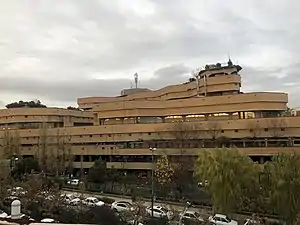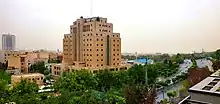| National Library and Archives of Iran | |
|---|---|
.png.webp) | |
 National Library building | |
| Location | Shahid Haghani Expressway, Davoodiyeh, Vanak Square, Tehran, Iran |
| Type | National library |
| Established | 1937 |
| Architect(s) | Yousef Shariatzadeh |
| Branches | 1 (Shahid Bahonar Street, Niavaran, Tehran) |
| Collection | |
| Items collected | Books, journals, newspapers, magazines, sound and music recordings, patents, databases, maps, stamps, prints, drawings,and manuscripts |
| Size | 15,000,000 |
| Legal deposit | Yes |
| Access and use | |
| Access requirements | Open to anyone with a need to use the collections and services |
| Other information | |
| Budget | 44 billion Iranian Rial (1,446,845 million USD) |
| Director | Alireza Mokhtarpour Ghohroudi |
| Website | www |
The National Library and Archives of Iran (NLAI) or National Library of the Islamic Republic of Iran is located in Tehran, Iran, with twelve branches across the country. The NLAI is an educational, research, scientific, and service institute authorized by the Islamic Consultative Assembly. Its president is appointed by the President of Iran. The NLAI is the largest library in the Middle East and includes more than fifteen-million items in its collections.[1][2]
History
Iran's national library and national archives began as separate institutions. In 2002, the two merged to form the National Library and Archives of Iran, but continue to operate in two independent buildings.
Library
The prototype of a national library in Iran was the Library of Dar al-Funun College, established in 1851. The college's small library collection became the cornerstone of the National Library. In 1899, another institution called the Nation's Library opened in Tehran.[3]
In 1934, Mehdi Bayani became the director of the Public Library of Education. In his efforts to solve space problems at the Public Library of Education, he promoted establishing a National Library of Iran to Ali-Asghar Hekmat, then Minister of Education. The National Library of Iran was established in 1937. Mehdi Bayani served as the National Library's first director.
André Godard, a French archaeologist and architect who designed the Museum of Ancient Iran, was asked to design a library building similar to the museum as the two would be adjacent. As the collection expanded, the library was housed in several buildings throughout Tehran.[2] In 1994, the Commissioning Organization for Public State Buildings of Ministry of Housing and Urban Development held a national competition to design a new building.[2]
The new building was constructed between 1996 and 2004 in Abbasabad, Tehran.[2][1] Yousef Shariatzadeh (Persian: یوسف شریعت زاده), Mohsen Mirheydar, and Yadollah Razaghi of Pirraz Consulting Planners, Architects and Engineers designed the building. which cost $53,930,769 USD.[2] It was dedicated on March 1, 2004, by Seyed Mohammad Khatami, then president of the National and Collective Documents and Library, in a ceremony attended by foreign writers, publishers, and ambassadors. The new library building won a design award from the Environmental Engineering and Architecture Forum in 1997.[2]
The National Library also includes twelve provincial branches: Boushehr, Ghazvin, Hamadan, Kerman, Isfahan, Mashhad, Rasht, Sari, Shiraz, Tabriz, Yazd, and Zahedan.
Isfahan officially Central Region including Kohgiluyeh Buyerahmad and Chaharmahal Bakhtiari keeps 7 -15 million documents.[4][5]
Since 2004, the National Library of Iran has had a beneficial relationship with the Library of Congress.
Archives
During the Qajar period, especially under Fath Ali Shah Qajar in the early 19th-century, documents were kept in the archives of the Biotat Office at the court. During the time of Nasser al-Din Shah in the mid to later 19th-century, political documents were stored at the Ministry of Foreign Affairs, and financial documents at the office of Mirza Yusuf Khan Mostofi al-Mamalik. In 1899, the Ministry of Foreign Affairs started following European archival methods by consolidating its archives and implementing the principles of document preservation.

In 1966, a bill to create a National Archive Organization of Iran was introduced. In 1970, the National Assembly approved the law establishing this organization. National records are, "All records, correspondence, offices, files, photographs, maps, clichés, charts, films, tape recorders and other documents that have been prepared by the government or have reached the government and are constantly in the possession of the government."
Facilities



The eight-story library building has 11,695 square metres (125,880 sq ft).[2] It is constructed of concrete that can withstand level nine-magnitude earthquakes. The overall design is organic and creates "an intimate and inviting atmosphere."[2]
The building consists of fifteen halls:
- Kharazmi Hall: rare books and manuscripts
- Khajeh Nasir al-Din Tusi Hall: links
- Kamal al-Molk Forum: non-book resources
- Ibn Nandim Hall: reference and bibliography
- Razi Hall: science and technology
- Ibn Sina Hall: humanities
- Farabi Hall: social sciences and arts
- Mohaddes Armavi Hall: Iranian Studies and Islam Studies
- Rudaki Hall: special section for the enlightened and the disabled
- Kamaluddin Behzad Hall: non-book resources
- Parvin Etesami Hall: women's hall
- Digital Forum
- Public Library: titles of Saadi and Hafez
- Children's Library
- Museum of Books and Documentary Heritage of Iran
Collections

The National Archives and Library of Iran houses three major collections: National Library, National Archive, and Digital.
The National Library incorporates collections from many older libraries. The majority of the collection consists of books and manuscripts covering the writings of Iranian scholars in the fields of literature, history, philosophy, mysticism, jurisprudence, medicine, and astronomy.
The collection also includes many rare and valuable manuscripts, such as calligraphy pieces by great masters. The smallest known octagonal Quran, measuring 3 by 3.3 centimetres (1.2 by 1.3 in), is a prized item in the collection. This Quran is important because of its antiquity and line cleanliness.
According to the Deputy of the National Library in 2019, the collection included:
- 2,841,665 books
- 301,782 dissertations
- 609,053 non-book resources, including photographs and CDs.
- 4,000,000 magazines in 140,619 volumes, including 24,997 Latin and Arabic publications
- 298,150 books for children and adolescents
- 23,323 books for the blind, including books-on-tape, books-on-CD, and around 1,000 Braille books
- 775 magazines for the blind and visually impaired
- 55,000 old books, including 28,158 manuscripts and more than 26,000 lithographs featuring old lead printing
- An Iranian Studies collection that includes 80,410 books, 2,300 dissertations, and 6000 journals
- An Islam Studies collection with 8,203,238 books, magazines, and tapes
- The library has fourteen halls with fifteen million library items.[1]
Publications
In 1962, the National Library took over the publication of the Iranian National Bibliography (Ketab-shenasi-e Melli-e Iran). It issued this annual publication between 1962 and 1966, changing to monthly and quarterly in 1969.[6][1] The NLAI also publishes a Biannual Journal of Oral History Research.[7]
See also
References
- 1 2 3 4 Kent, Allen and Lancour, Harold and Daily, Jay E. (eds.). "Iran, Libraries". Encyclopedia of Library and Information Science. vol. 13. New York: Marcel Dekker. pp. 26–28
- 1 2 3 4 5 6 7 8 Mehrazan. "National Library of Iran - Contemporary Architecture of Iran". www.caoi.ir. Retrieved 2022-09-12.
- ↑ Murray, Stuart A. P.. (2009). The Library: An Illustrated History. New York: Skyhorse Publishing/Chicago: ALA Editions, 2009.
- ↑ "7میلیون سند تاریخی در مرکز اسناد اصفهان نگهداری می شود » اصفهان امروز آنلاین". اصفهان امروز آنلاین (in Persian). Retrieved 2023-07-03.
- ↑ "توسعه فعالیت مرکز اسناد و کتابخانه ملی اصفهان نیازمند تغییر نگرش مردم است - ایرنا". www.irna.ir. Retrieved 2023-07-03.
- ↑ George Chandler (1971). "Iran". Libraries in the East: an International and Comparative Study. Seminar Press. pp. 39–50. ISBN 0-12-815550-7.
- ↑ "Biannual Journal of Oral History". joralh.nlai.ir. Retrieved 2022-09-11.
External links
![]() Media related to National Library of Iran at Wikimedia Commons35°45′8.53″N 51°26′3.67″E / 35.7523694°N 51.4343528°E
Media related to National Library of Iran at Wikimedia Commons35°45′8.53″N 51°26′3.67″E / 35.7523694°N 51.4343528°E